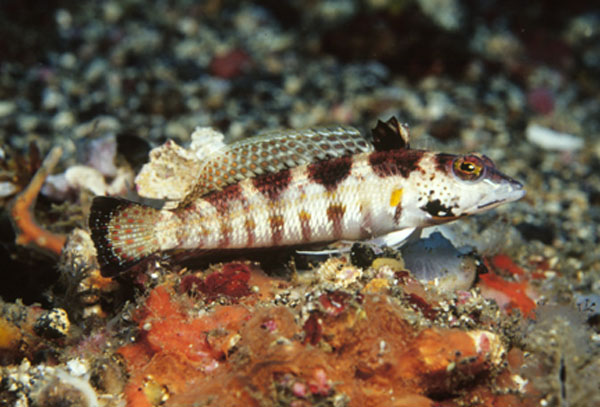| Pinguipedidae (Sandperches) |
| 11 cm TL (male/unsexed) |
|
reef-associated; marine; depth range 10 - 40 m |
| Indo-West Pacific: southern Japan to Queensland and Western Australia. |
|
Dorsal spines (total): 5-5; Dorsal soft rays (total): 20-21; Anal spines: 1-16; Anal soft rays: 18. This species is characterized by the following: D V,20-21 (usually 21); A I,16-18; 13-15 (rarely 13, usually 14) pectoral rays; 38-43 lateral-line scales; about 2-4 + 7-10 gill rakers; about 4 predorsal scales; ctenoid scales on cheek, in 4 horizontal rows; front of lower jaw with 8 canine teeth; vomerine teeth a broad chevron-shaped patch; with palatine teeth; upper edge of subopercle with a prominent sharp spine; serrae on opercular bones absent; body depth 4.15-4.75 in SL (21.20-24.1% SL); middle dorsal spine longest; membrane from last dorsal spine joined near base of first soft ray; body gray to reddish dorsally, white below with the edges of scales gray; a series of f5 broadly U-shaped dark brown bars on back, smaller posteriorly, or with a series of 5 double dark brown to black dashes, the anterior 2 with 1 above and 1 below lateral line; a series of 9 spots or short bars on lower side of body that may be blackish, reddish, or dusky yellow; small dark reddish spots, one per scale, often present scattered along side of body and on cheek; presence at side of snout of an iridescent pale blue line, and one beneath eye; lips with large dark blotches; usually presence of a midventral blackish spot on isthmus, often with a smaller black spot to each side anteriorly; edge of chin below lower lip dusky to blackish; spinous portion of dorsal fin may be entirely black, but usually blackish with large pale yellowish blotches in outer part; soft dorsal fin with rows of black to black-edged orange spots, the base of most rays black or with black upper ends of U-shaped marks extending into base of fin; anal fin base with a row of red spots, a red submarginal line, and a small black spot on penultimate membrane about one-third distance to margin; caudal fin with small blackish, dusky orange, or red spots, often with smaller white spots as well (Ref. 57562). |
| Found in silty sand and rubble areas near reefs at depths of 10-40 m (Ref. 2334, 90102). |
|
Least Concern (LC); Date assessed: 20 April 2022 Ref. (130435)
|
| harmless |
|
Recorded from Raja Ampat Islands, Bali, Manado and vicinity, Pulau Seribu and Pulau Weh; with an Indonesian distribution from Papua to Sumatra (Ref. 47567). Included for comparison with Indonesia species that all appear to be undescribed. The male pattern on the cheek and lower lip is typical for the species and is different in the Indonesian species (Ref. 48636). |
Source and more info: www.fishbase.org. For personal, classroom, and other internal use only. Not for publication.

